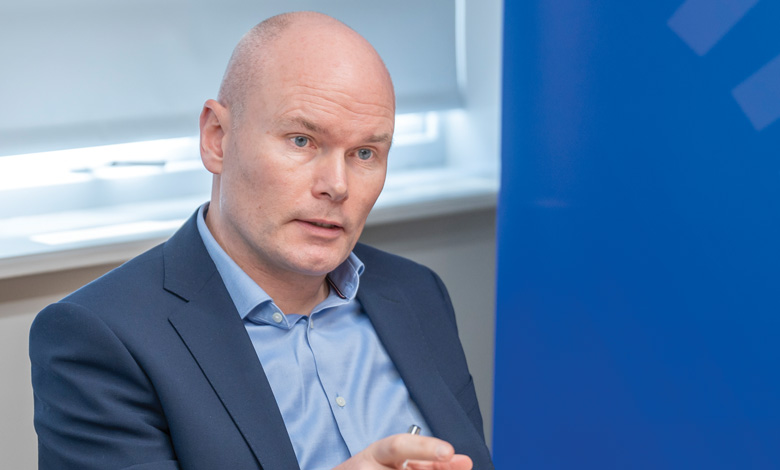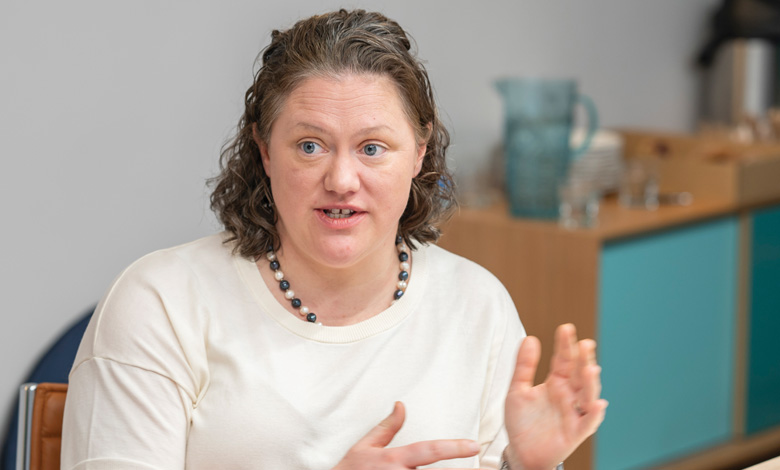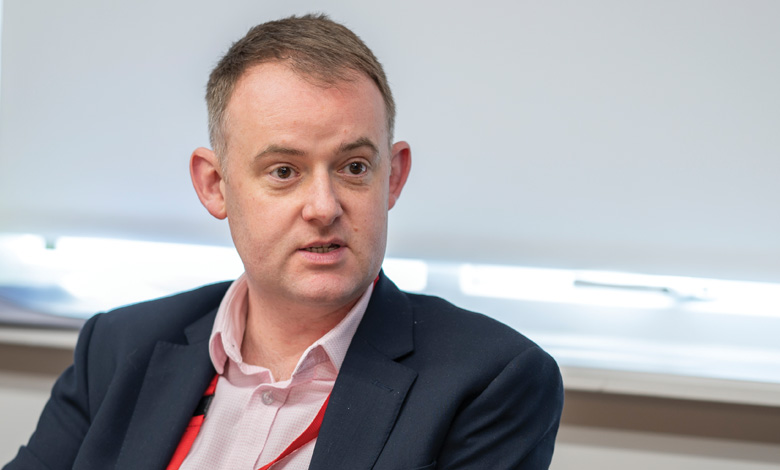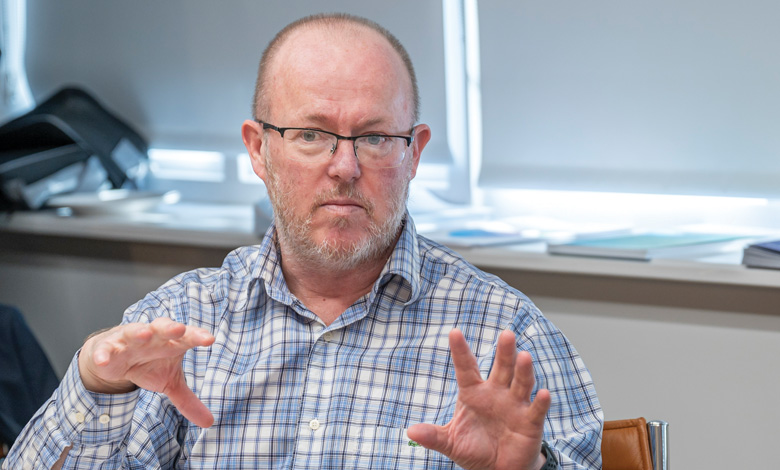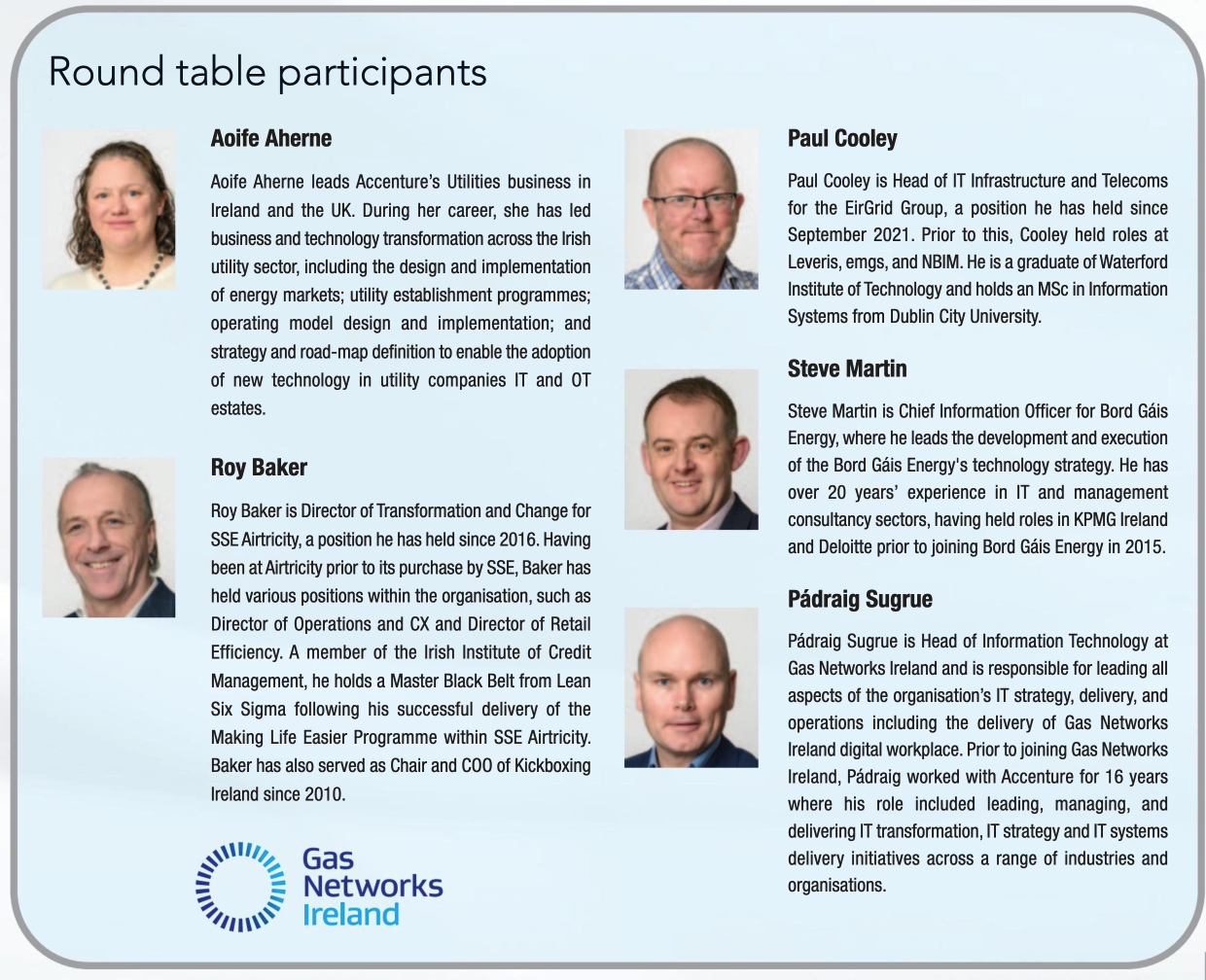Powering the digital workplace in the energy sector
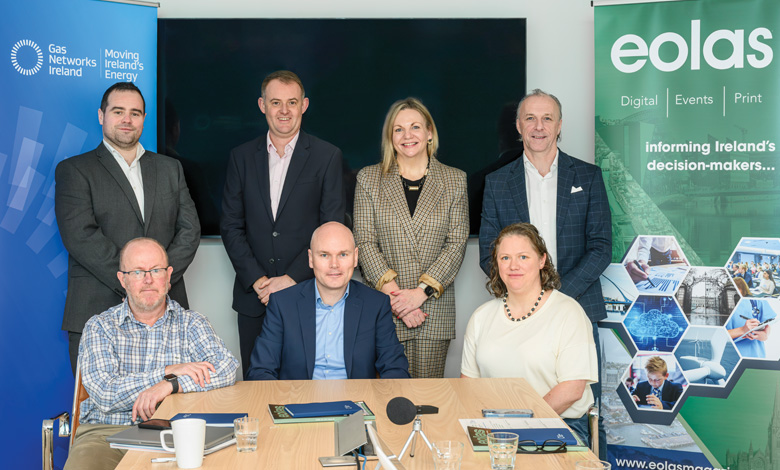
Gas Networks Ireland hosted a round table discussion with key stakeholders in the utility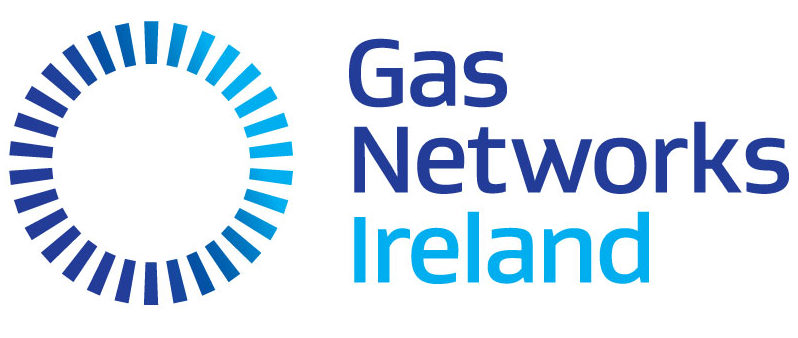 sector to discuss the challenges and opportunities presented by digitalisation of the energy sector.
sector to discuss the challenges and opportunities presented by digitalisation of the energy sector.
How has Ireland’s energy sector been impacted by the digitalisation of the corporate workplace environment in recent years?
Pádraig Sugrue
The biggest change undoubtedly has been the move towards remote working, which has seen significant IT investment in new tools, collaboration capability, technological devices, and meeting room technology. The feedback on this change has been overwhelmingly positive from an employee’s perspective. However, from an IT perspective, it has taken big investment to ensure that the solutions we provide are highly reliable. That onus that has always been on IT departments to provide secure, highly available systems, and this has now transitioned onto the whole digital workplace environment in terms of ensuring people are able to work productively regardless of their location.
Steve Martin
The pandemic was a catalyst for collaboration tools and remote technologies, but it feels like the next iteration of change is coming. For example, we are currently trialling the use of Microsoft Co-pilot productivity tools, which have a mix of functions, such as AI-generated meeting summaries and email drafting capabilities. It is early days, but these emerging technologies will significantly optimise collaboration in the future. There is absolutely more to come, which will be essential to meet increasing customer and employee expectations.
Paul Cooley
The pandemic mandated a transition for everyone and moved us from desktops to laptops and mobile devices, and that brought with it a mindset and culture change. People no longer feel restricted to a desk, but they also do not feel like they own a desk space, which is completely different to how they operated previously. I joined EirGrid at the back end of Covid and I found that people were not as embedded in the ethos of the organisation that they were in because they had been at home for a year and a half, and the return was transformative. None of the meeting rooms were Teams-enabled when we came back, for example, and that was a huge issue for us in the IT area. The change has been for the better and I am really enjoying the Teams AI function; it requires a different mindset, and I am all for it.
“Post-Covid, the focus for many organisations has been on the corporate workplace and remote enablement but it feels like now is the right time to refocus back on the field workplace and assess how we can improve productivity and safety with new technologies.”
Pádraig Sugrue
Aoife Aherne
Workplace digitalisation traditionally struggled to attract investment, particularly in the regulated utility sector. The pandemic triggered an increase in investment in workplace enablement. It also exposed gaps in IT asset management, with businesses blind to the multiple hardware and software configurations in their estate. With these challenges addressed, the path to increased adoption of cloud-based solutions in the digital workplace is smoother. Overall, the change has been positive and employee expectations of the digital workplace is high and driving demand for the digitalisation of other employee services.
Roy Baker
Large corporate groups traditionally move slowly and carefully. We always had consideration of remote working, but Covid served as a catalyst to move into areas within three weeks that normally, it would have taken us two or three years to prepare. Digitalisation and remote working have changed the culture within our organisation. We are particularly more attuned to cultural diversity now and we have learned to be more dynamic, where we are now dealing with offshores that are purely online and agencies from different cultures. We have also had to change our capabilities to deliver services to customers with different expectations, but that need to be balanced with an outlook that nothing beats in-person workshops to work through a complicated problem.
“Overall, the change has been positive and employee expectations of the digital workplace is high and driving demand for the digitalisation of other employee services.”
Aoife Aherne
What is the single most significant challenge aligned to the digitalisation?
Paul Cooley
For me, it is the threat landscape that exists. The opportunities presented by digitalisation are also the challenges; we give staff devices to be agile and work from home, but we also need that environment to be office secure. There is a cultural shift needed whereby the security habits that exist in the office transfer to the mobile working environment. IT is catching up and things like the zero-trust security model are enabling capability for feeling safe and secure, but we are all on a journey to navigate the threat landscape.
Roy Baker
Importantly, it is not just the volume of threats that is challenging but more and more, it is the complexity. When you are operating a critical infrastructure, with that can come a level of intent from cyber criminals to directly target the likes of energy companies in an attempt to shut down the network. The reality is that these criminals are agile and using extraordinary measures on a daily basis, so the greatest challenge is staying ahead of the curve.
Steve Martin
There is an irony in that the benefits of digitalisation are also the means by which cyber criminals are given opportunities to attack. The best defence is to be continuously ahead of the threat, but that is not easy. A further challenge linked to digitalisation is that of prioritisation. Often simplifying and improving existing capabilities within an organisation is more effective than investment in something new. New platforms and new tools can be a distraction to efficient digitalisation, because often it is easier to build a business case for new technologies, than it is for simplifying existing systems or building data enablers. The challenge comes from finding a balance between those dimensions of new tooling, simplification of existing, and foundational enablers.
Pádraig Sugrue
I would agree that the greatest challenge we face is the risk of cyberattack, and as a consequence the need to ensure that there is sufficient protection and controls built into the digital workplace solutions that we provide to our employees. This is not always easy and requires a careful balance between meeting the needs of the business or individuals, while at the same time not compromising our security posture or the necessary preventative controls that need to be in place.
“It is too early to place one big bet, so it is about trying new things, capturing the lessons – and hopefully having a bit of fun along the way.” Steve Martin
Aoife Aherne
I agree that cyber threat is probably the biggest risk, however, in terms of challenge I would lean more towards employee engagement. The decarbonisation challenge will require the mobilisation of a diverse multi-disciplinary workforce. Current and future generations of graduates and apprentices are digital natives who expect modern, flexible digital workplaces. As we meet this need, we must be sure to get the balance right and harness the benefits of in-person teaming, learning and collaboration.
Roy Baker
To some extent that agility is a challenge. Post-Covid, skilled workers are now more transitional, and the workforce is more fluid. That means it is more difficult to attract talent, but it is also more difficult to retain them, particularly in specialised areas such as cyber and IT.
Aoife Aherne
AI, and particularly generative AI, capabilities are now at the disposal of organisations who have invested in a secure digital core. As organisations move from experimentation to scaled implementations for many there is a big gap between responsible AI intention and action. In recent Accenture Research, we found that only 2 per cent of businesses say they have fully operationalised responsible AI across their organisation, with a further 31 per cent expected to do so in the next 18 months.
“Emerging technologies are going to alter how our energy systems work, they are going to change market, retailer, and consumer relationships, but technology also has a role in helping to understand, manage, and even predict changes.”
Roy Baker
To what extent will emerging technologies unlock new benefits for the energy sector?
Roy Baker
One of the major challenges facing the energy sector is understanding the relationship between generation, supply, and demand side management of the future. The electrification of transport is a good example of how technology changes have put pressure on the grid and to prevent this happening to future energy systems, we need to be able to see over the horizon. Emerging technologies are going to alter how our energy systems work, they are going to change market, retailer, and consumer relationships, but technology also has a role in helping to understand, manage, and even predict changes.
Aoife Aherne
Looking at it from the perspective of those delivering services at the coalface, field mobility has been a key part of service delivery in the utility sector since the early noughties. Since then, we have seen field mobility capability mature, both in terms of hardware and software. What we have not really seen, particularly in the UK in Ireland, is the adoption of wearable, hands-free technologies, where the connected field worker has access to over the shoulder coaching, for example. It is interesting that these technologies have emerged in other sectors, such as oil and gas, aided by the availability of robust telecom networks in large sites like refineries. These technologies are proven and have helped improve accuracy, efficiency, and the field workers’ experience. The question now is how can utilities learn from other sectors to incrementally exploit and adopt some of these now proven technologies?
Roy Baker
SSE recently piloted a technology with our gas and solar teams across Ireland whereby AI on an engineer’s phone was used to conduct audit checks. Over 110 people a day have been using the technology over the course of a year and it has been very well received because it improves safety and offers confidence to engineers.
Pádraig Sugrue
In Gas Networks Ireland, we feel that we are close to a connectivity tipping point whereby emerging technologies such as wearables could soon become a viable option. For the past 10 to 15 years, we have had technology utilised by our field workforce and that technology has evolved organically over time with the addition of new capability such as survey, GIS, and other apps. In the past, there has been challenges in relation to telecoms and bandwidth for remote locations but that is now changing with advances in this area. Post-Covid, the focus for many organisations has been on the corporate workplace and remote enablement but it feels like now is the right time to refocus back on the field workplace and assess how we can improve productivity and safety with new technologies, including the rollout of Office 365 and Teams
Steve Martin
In adopting emerging technology for our field workforce, it is fundamental that we engage with our colleagues to fully understand their pain-points and the opportunities to help them better meet the needs of our customers. Simply designing a process and interface in the office and assuming it will be fit for a field-based engineer just does not work. Design considerations must involve engineers who will be using the technology – and we have a great opportunity to ‘test and learn’ in this space with the emerging technologies on the horizon.
Aoife Aherne
Another element of this is around support. A technology problem in the home office can often be ‘worked around’ by the office worker; however, technology problems in the field can have an immediate impact on field worker efficiency and safety. There is a need for a bespoke support service for field mobility, particularly as we roll out new digital and AI enabled technologies.
“The opportunities presented by digitalisation are also the challenges; we give staff devices to be agile and work from home, but we also need that environment to be office secure.”
Paul Cooley
Paul Cooley
If the true benefits for the energy sector are going to be realised through emerging technologies, then there must be greater understanding and awareness among the public of the requirements for this technology. In recent months there has been a spike in interest from the end user about the electricity system, spurred by an increase in bill costs. If we are to fully embrace the 10-years ahead mindset then there needs to be buy-in that these future technologies and future systems will require infrastructure, change, and investment.
Pádraig Sugrue
That 10-year horizon scanning is important, and for example in Gas Networks Ireland we are in the process of developing an AI strategy and roadmap which looks to the future, but also aims to cut through the current hype around AI and bring it back to the basics of where AI can deliver clear value for our organisation in the near-term. Value is not only about revenue generation, but also increasing the productivity of people and the workforce. A number of interesting AI use cases exist around things like demand forecasting and network planning which could potentially be very useful, but we do need to assess as part of our strategy what value they could bring in the context of our specific organisation.
Aoife Aherne
The potential for value from AI is clear – however it is not plug-and-play; to scale, you must deeply understand the technology, which is still rapidly changing, and the business value it will bring. The sectors furthest ahead on the journey include banking, communications/media and software and platforms business. In our regulated utility sector, scaled adoption will be considered and measured. Investment will be needed to identify business value; establish secure digital foundations, particularly scalable data platforms in the cloud; prepare the workforce; and close the gap on responsible AI. This is a multi-year journey.
How is your organisation balancing the demand for increased digitalisation of the workplace environment with the need for human interaction and engagement in an increasingly hybrid workforce?
Roy Baker
It is around distraction management, understanding where we are placing our bets. We cannot place our bets everywhere, so it is about making an informed decision on where we believe the industry and the consumers are going to go. You cannot try and do everything, so distraction management is key.
Aoife Aherne
There are two things that we are focused on to achieve this balance: firstly, our people, and how we engage them and bring them together in an increasingly hybrid world; and secondly, how we capture value from AI. We have been on our own generative AI journey for nearly 18 months and in our experience, the real accelerator with generative AI is not the technology, it is people. To that end, it is about rethinking our talent strategy for the age of AI because every single person in our business will use GenAI in the future. So for us it is about considering ‘how the work that we do will change with AI’, ‘how our workforce needs to change’ and ‘how we get our workers ready for this’.
Paul Cooley
The big challenge for us is what is coming with offshore wind. We must figure out how to manage that and get ahead. There is a huge amount we can do with things like digital twins to get up to speed and that will all be set by data. We need to create a data platform to cope with everything that we need.
Steve Martin
We are in the test and learn phase, setting up an innovation practice. There is all this possibility, and we are trying to get the balance between innovations that support customers, colleagues, and the technology function itself. We are addressing the key foundational enablers to be ready in the future, whilst also trying things. It is too early to place one big bet, so it is about trying new things, capturing the lessons – and hopefully having a bit of fun along the way.
Pádraig Sugrue
It is certain that we will see increased digitalisation and use of AI in the coming years. What the last few years have taught us is that it cannot be a one-size-fits-all approach when rolling out this new capability in our organisations. Graduates coming out of college have a very different expectation of digitalisation compared with someone who has been in the workplace for 30 or more years. That is not going to change because we introduce more digitalisation, it is something that we are going to have to manage carefully as we continue on this journey.

